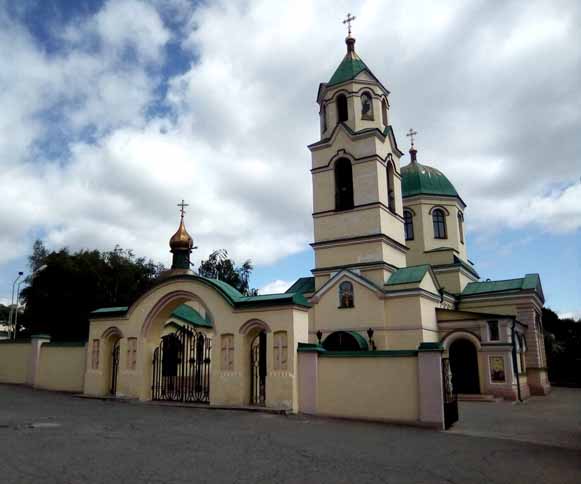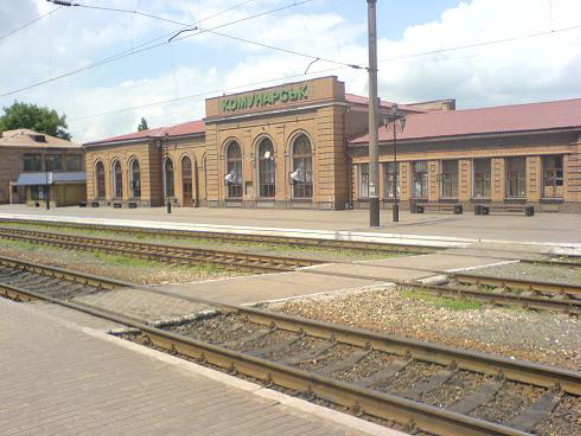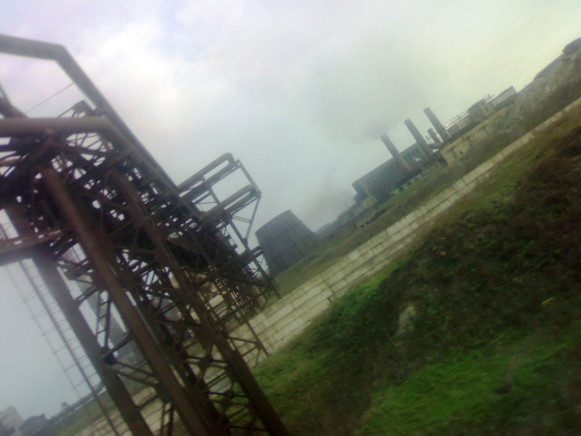Alchevsk
Alchevsk [Алчевськ; Alchčevs'k]. Formerly Voroshylovsk (1931–61), then Komunarsk (1961–92) on Map: V-19, DB Map: DBIII-5. City (2020 pop 107,000), under oblast jurisdiction, in the southwestern part of Luhansk oblast; since 2014 occupied by the pro-Russian separatists of the so called ‘Luhansk People’s Republic.’ Located on the Debaltseve–Luhansk rail mainline (double-tracked, electrified) and on Highway M-04 45 km west of Luhansk, it was built on an undulating plain, gently sloping to the northeast, near the upper reaches of the Bila River (right tributary of the Luhanka River, a right tributary of the Donets River). It borders smaller coal mining cities (with estimated 2020 populations) of Perevalsk (25,000) to the south, Kypuche (formerly Artemivsk, 7,200) to the west-southwest, and to the northwest the industrial conurbation of Brianka (51,000), Almazna (4,200), Kadiivka (74,000), Irmino (9,400), Pervomaisk (Luhansk oblast) (36,500), and Holubivka (formerly Kirovsk, 27,000).
History. Alchevsk was established in 1895 as a workers’ settlement Yuriivka of the Donetsko-Yurievske Metallurgical Company, the only non-foreign-owned metallurgical company in the Donets Basin. The metallurgical plant was founded by the Ukrainian industrialist, Oleksii Alchevsky, next to the railway station Yuriivka; its eponymous settlement incorporated the adjacent 18th century villages of Zhylivka and Vasylivka (the latter with an Orthodox church from the early 19th century). During the financial crisis in 1901 Alchevsky, rejected by the Russian government for financial support of his company, committed suicide. In 1903 Yuriivka was re-named Alchevsk in the founder’s honor as the plant was acquired by a Belgian-French firm, which grew the enterprise and the settlement. The specialists were Belgian, French, and German, the skilled workers drawn from other metallurgical plants and unskilled labor from both adjacent regions and more distant parts of the Russian Empire. By 1913 the plant employed 5,135, which supported Alchevsk with a population of 16,200 in 1914.
During Ukraine’s struggle for independence (1917–20) and Russia’s civil war, Alchevsk changed hands numerous times. Armed forces entered Alchevsk as follows: the Ukrainian State troops, assisted by Germans, on 26 April 1918; the Don Cossacks of General Petr Krasnov in December, 1918; and the White Army of General Anton Denikin, in June, 1919. The Bolsheviks and their recruited factory workers took control between each incursion. On 26 December 1919, the Red Army drove out the White Army and the Bolsheviks gained ultimate control of the city.
The Soviet state nationalized the metallurgical plant in Alchevsk (now the Alchevsk Metallurgical Complex). Having no funds to invest and operate it, the government temporarily conserved it and reassigned its workers elsewhere. By the end of 1923, the population of Alchevsk declined to 8,000. With the resumption of its operation in the beginning of 1926, by 17 December 1926 the census revealed that the population of Alchevsk doubled to 16,000, with an ethnic composition of 58.9 percent of Russians, 27.3 percent of Ukrainians, and 5.3 percent of Jews.
Industrial expansion in Alchevsk included the addition of new blast furnaces and shops to the original metallurgical plant and the construction of a coke-chemical plant, which began production in 1929. In 1931 the city was renamed Voroshylovsk, after a prominent local Bolshevik leader, Klyment Voroshylov. In 1932 the city began its transformation with broad streets, multi-story buildings, piped water supply and sewers, and the establishment of squares and parks. In 1938 the city reached the coal-mining settlement Paryzka Komuna in the south, which was re-named Perevalsk and designated administrative center for the Perevalsk raion. By 1939 the population of Voroshylovsk had reached 55,000.
During the Second World War, upon German invasion the equipment of the metallurgical and coke chemical plants was evacuated to the Kuzbas in Siberia and Begovat in Uzbekistan. The Germans took the city on 12 July 1942 and held it until 2 September 1943.
Reconstruction of the city involved mobilization of specialists from all parts of the USSR. The ‘Alchevskbud,’ a reconstruction trust, was established in 1943. It expedited the rebuilding and re-equipping of the former plants with new blast and open-hearth furnaces, rolling mills, coke and chemical shops. New construction, clothing, and food industry enterprises were established to supply the basic needs of workers. As a result, in the first post-war Five-Year Plan (1946–50), the city’s industrial output reached and exceeded the pre-war output. In time, the social sphere was enhanced with the development of public transit, schools, culture halls, libraries, movie theaters, stadiums, and sports facilities. In 1961, the city was re-named Komunarsk.
In the postwar years the city’s population grew from 78,000 (1956) to 98,000 (1959), and 123,000 (1970), then stagnated towards the end of the Soviet period in 1989 at 125,000. The ethnic composition of the city in 1989 was 50.4 percent Russian and 45.9 percent Ukrainian; the remaining 3.7 percent were other minorities, including Belarusians, Tatars, Jews, Armenians, Moldovans, Poles, Gypsies, and Georgians.
Following Ukraine’s independence (1991) the city’s population peaked at 127,000 (1995) and began a decline: 124,000 (1996), 120,000 (1999), and 119,000 in the census year of 2001. By then, ethnic composition shifted to a Ukrainian majority of 51.6 percent, followed by 44.7 percent Russian, and 1.1 percent Belarusian, with 2.6 percent of the remaining nationalities. Linguistic Russification took hold, as indicated by the declaration of mother tongue: 83.6 percent Russian, 15.3 percent Ukrainian, and 1.1 percent other. Religious institutions revived, small private services emerged to satisfy consumer needs. The city’s large industries, lacking government support, were run down and then privatized. The population of the city, as a result of aging and out-migration, continued to decline: 117,000 in 2005, 114,000 in 2010, 110,000 in 2015, and 107,000 in 2020.
The 2014 hostilities in Alchevsk began in March with the pro-Russian activists forming the so-called Alchevsk Guard. On April 30 they occupied city hall, removed the Ukrainian flag and demanded the mayor hold a referendum for joining the ‘Luhansk People’s Republic.’ The pro-Ukraine activists re-took city hall and re-instated the Ukrainian flag. But the more powerful pro-Russian forces organized their own referendum on May 11 and on May 25 prevented the holding of elections for the President of Ukraine. After June 6, when the separatist forces seized the local offices of the Security Service of Ukraine, the city came under control of the ‘Don Cossacks.’ Active battles for Alchevsk between Ukrainian forces and the pro-Russian separatist occurred in August, but did not reach the streets of the city itself. Even so, there were casualties and damage. The city remains controlled by the pro-Russian militants. Its industries have come to a halt, were seized by the militants and re-started with Russian help. But difficulties in maintaining operations resulted in negative socio-economic consequences.
Economy. Before 2014, Alchevsk was, after Luhansk, the second largest industrial producer in Luhansk oblast. Built around the Alchevsk Metallurgical Complex, including the Alchevsk Coke-Chemical Plant, Alchevsk became one of the largest metallurgical centers in the Donets Basin. Industrial expansion also diversified into construction and building materials, machine-building, wood-working, printing, clothing, and food products.
The basic economic driver of Alchevsk was the Alchevsk Metallurgical Complex. Established in 1895 as a metallurgical plant, by 1915 it had 5 blast and 7 open-hearth furnaces and rolling mills. It was nationalized in 1920 and complimented in 1929 with a coke-chemical plant which produced the coke needed for the metallurgical plant and other chemical byproducts; re-built after the Second World War the two plants were merged as a complex in 1984. It was privatized in 1994 (co-owned by the Industrial Union of Donbas [principal owner, Serhii Taruta], and Interpipe Group [principal owner, Viktor Pinchuk]; in 2002, it became fully owned by the Industrial Union of Donbas; renovation of the complex began in 2003, including the most modern coking battery in Ukraine or Russia; by 2011 the coking plant produced 3 million tons of coke; in 2014 the complex employed 13,447 workers and produced 2.4 million tons of steel a year. With war in the Donbas beginning in 2014, it ceased production in 2015. Seized by militants, the complex was taken over by the Moscow-based Vneshtorgservis (of Serhii Kurchenko) and restarted in December, 2017; that month it produced 118,000 tons of coke, 155,000 tons of pig iron and 158,000 tons of steel. By 2021 all of its blast furnaces stopped production for lack of coke.
The fate of other related enterprises varied. The steel shot works, producing steel shot and steel grit, remained in Alchevsk. The company Metals and Polymers, makers of polymer-covered galvanized steel, stopped operations in 2014 and moved to Pervomaisk in Mykolaiv oblast.
Culture and education. In the Soviet period the cultural institutions focused mainly on support for industrial development. This legacy remains in Alchevsk: a technical university and four vocational-technical schools. The Donbas State Technical University (founded in 1957 as the Voroshylovsk Mining-Metallurgical Institute, re-named in 1964 after the city’s name change to the Komunarsk Mining-Metallurgical Institute) was re-named in 1992 the Donbas Mining-Metallurgical Institute and upgraded in 2004 to its current name. It spawned branch departments in the cities of Krasnodon, Krasnyi Luch, Lysychansk, Pervomaisk (Luhansk oblast), Rovenky, Sverdlovsk, and Yenakiieve; after the 2014 hostilities, the pro-Ukrainian administration and faculty moved its head office to Lysychansk; others remained in this now unrecognized jurisdiction. The four vocational-technical schools with their current names are: the Industrial Technikum of the Donbas State Technical University, the Alchevsk Professional Metallurgical Lyceum, the Alchevsk Professional Commercial Culinary Lyceum, and the Higher Professional School. Extracurricular education was provided by two music schools, one fine arts school, two sports schools, and four youth centers of creativity.
Sports facilities include: 1. the Stal Stadium, home of the Stal (Alchevsk)’ football club (established in 1935 as Stal [Voroshylovsk], then Metalurh [Komunarsk] [1963–4], Komunarets [Komunarsk] [1964–89], Stal [Alchevsk] [since 1989], played in the first league in Ukraine since 1992); 2. the Park Stadium, a sports field in the 30th Anniversary Victory Park; 3. the Budivelnyk Stadium; and 4. the Stal Sports Palace. In addition, there are 2 youth sports schools, including the Budivelnyk sports complex; several school sports fields; a swimming pool; and a yacht club (on the Isakivske Water Reservoir of the Bila River, 8 km east-southeast of the city center).
Alchevsk is home to six museums: 1. city history (established 1967), 2. history of the metallurgical plant, 3. history of the coke-chemical plant, 4. history of the university, 5. archeology, and 6. geology and mineralogy. The city has three palaces of culture, three movie theaters, and a recreation center.
Before 2014 there were 10 newspapers and 3 magazines published in the city. Since then they have been sharply reduced. The city’s official newspaper, Ogni, continues as a Russian-language weekly that appeared under different titles: Za kommunizm, Ogni kommunizma. There is an information-advertising weekly, the RIO. On the Alchevsk radio there is a 15 minute daily local newscast, and on its television ‘Asket’ the same four times a day.
Church life in Alchevsk revived with Mikhail Gorbachev’s glasnost and Ukraine’s independence. The oldest church in Alchevsk, the Saint Nicholas Cathedral bears testimony to its history. It originated as a one-altar church in Vasylivka in 1808. In 1899 two transepts with side altars were added as the church expanded to cater to the growing population. After the Bolshevik takeover the church was closed, robbed, used as a dairy in the 1930s; during the Second World War it served as a hospital, was opened for church service during the German occupation, and after Soviet return was allowed to function, but with strict monitoring and restrictions. In 1990, pressure eased, bells were re-installed; in 1992 a new bell-tower and cupola were added, giving the church its current grand design, and in 1993 a school was built for religious instruction, providing a start for young people to enter theological seminaries elsewhere to train for priesthood. The church is proud to be a repository to some significant holy relicts.
Alchevsk has three other recently built churches of the Ukrainian Orthodox Church-Moscow Patriarchate: 1. the Church of the martyrs Faith, Hope, and Love, and their mother, Wisdom, built 1996–2000; 2. Saint George’s Church, built 2000–2001; and 3. Saint Volodymyr’s Church, built 2011–2 (in Administratyvnyi settlement). There are also the ‘Aliman’ Mosque (near the southern periphery of Alchevsk), and a Jehovah’s Witnesses Hall (in the Lyman district).
City plan. On a map the Alchevsk city border presents an irregular shape, about 8 km east to west and 8 km north to south, with an area of 49 sq km. The mainline railway arches from the southwest, passes just north of the center, and on to the east-northeast. The city’s western and central belt, along the south side of the mainline track, is industrial (from west to east, the coke-chemical plant, the smelter, and the rolling mills, with slag heaps in the southwestern periphery and the northeast). There is another industrial outlier on the eastern side along the south side of the mainline, as well as some small areas in the south. A spur line from Kupyche (formerly Artemivsk) serves the industries of Perevalsk and those in the southern part of Alchevsk. The Highway M-04 from Donetsk to Luhansk follows this route as well, bypassing the Alchevsk city center.
The railway passenger station for Alchevsk, still called Komunarsk, is on the north side of the main-line tracks, in Zhylivka, the city’s northern district and former village with residential and industrial development; the rest are open fields, settling ponds in the west, slag heaps in the east and two outlying settlements, Administratyvnyi and Bryketnyi in a wooded area in the north. A roadway tunnel under the tracks and part of the steel plant connects this northern outlier to the rest of the city.
Most built-up parts of the city lie south of the main-line tracks and the industrial belt. They are: the small Old City, and south of it, the large New City, the residential district of Vasylivka east of the Old City, and the large Lyman district east of the New City. In the southern periphery, both the New City and the Lyman districts change from large apartment blocks in the north to individual residential housing in the southern periphery.
The Old City, located directly south of the steel plant, has a number of attractions. From west to east they are: the entrance to the steel plant, consisting of a square with a bust of the founder, Oleksii Alchevsky, and across from it, a memorial square to victims of Fascism; next is the Museum of the History of the Alchevsk Metallurgical Plant (housed in a late 19th century factory director’s building), the Scientific-Technical Library and then 0.5 km to the southeast, the central city market, and east of it, Saint Nicholas’s Cathedral. East of the cathedral extends (for 3 km) the residential district of Vasylivka, comprising single-storey houses. A creek, also called Bila (with several ponds, joining Bila River farther east), separates the Old City and Vasylivka from the New City to the south. The New City consists of a grid of wide streets and avenues, lined with multi-storey apartment blocks. It houses most institutions, parks and sports facilities. In the newer, eastern half of the city, which is the northern half of Lyman district, the buildings are higher and the streets even wider. Some New City attractions (such as the Donbas State Technical University Library and several of its halls, the Geology-Mineralogy Museum, and the Archeological Museum) border on the Old City. The newer, northern part of Lyman district houses some institutional buildings as well: the municipal court building; the city hall, and the central city library. Two large churches were also built in this area: Saint George’s Church and the Church of the martyrs Faith, Hope, and Love, and their mother, Wisdom. The eastern half also has two smaller markets.
Urban public transit is supplied by trolley buses (8 routes), scheduled minibuses and taxis. Buses and minibuses provide service to nearby cities as well. The Alchevsk inter-city bus terminal for long distance travel (mainly to the Russian Federation) is located next to the Highway M-04 bypass in Perevalsk. Train passenger service is limited now to suburban connections, since long distance service to other cities of Ukraine was cut by hostilities in 2014.
BIBLIOGRAPHY
Iehorov, Iu. et al. ‘Komunars'k’ in Istoriia mist i sil Ukraïns'koi RSR. Luhans'ka oblast' (Kyiv 1968)
‘Komunars'k’ in Heohrafichna entsyklopediia Ukraïny (Kyiv 1993)
‘Alchevsk: Plan goroda’ 1:15,000 in Mista Ukraïny (Kyiv 2004)
Karta Alchevs'ka, Luhans'koi oblasti (2020) https://kartaukrainy.com.ua/Alchevsk
Ihor Stebelsky
[This article was updated in 2021.]



.jpg)

.jpg)